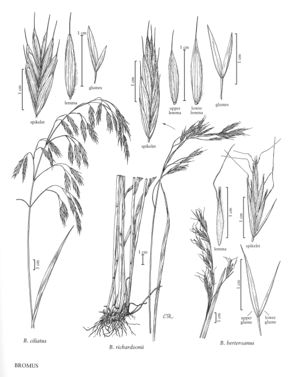Bromus berteroanus
Plants annual; often tufted. Culms 30-60 cm, slender. Sheaths pilose-pubescent to nearly glabrous; blades 7-28 cm long, 2-9 mm wide, pilose or glabrous. Panicles 10-20 cm long, 3-9 cm wide, erect, dense; branches appressed to spreading, sometimes flexuous. Spikelets 15-20 mm, elliptic to lanceolate, more or less terete, with 3-9 florets. Glumes glabrous, acuminate; lower glumes 8-10 mm, 1-veined; upper glumes 12-16 mm, 3(5)-veined; lemmas 11-14 mm, lanceolate to linear-lanceolate, sparsely pubescent, 5-veined, rounded over the midvein, apices acuminate, bifid, teeth 2-3 mm, usually aristate, sometimes acuminate; awns 13-20 mm, geniculate, strongly to moderately twisted in the basal portion, arising 1.5 mm or more below the lemma apices; anthers 2-2.5 mm. 2n = unknown.
Distribution
Utah, Calif., Ariz., Oreg., Nev.
Discussion
Bromus berteroanus is from Chile, and can now be found in dry areas in western North America, including British Columbia, Montana, California, Nevada, Arizona, southwestern Utah, and Baja California, Mexico.
Selected References
None.
